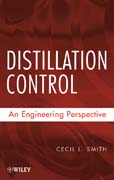
Today, distillation is by far the most common separation technique used in the chemical and petroleum industries. Distillation Control approaches this subject from a process engineering perspective to explain the use of steady-statesimulations to develop, to analyze, and to troubleshoot all aspects of columncontrols, including their practical application and cost benefits. Practicingengineers and other professionals working in process facilities that use distillation to separate materials will find this book a reliable companion. INDICE: Preface ix1 Principles 11.1. Separation Processes 21.2. Total Material Balance 91.3. Refl ux and Boilup Ratios 131.4. Total Material Balance around Condenser 181.5. Total Material Balance around Reboiler 211.6. Component Material Balances 241.7. Energy and the Separation Factor 281.8. MulticomponentDistillation 351.9. Stage-by-Stage Separation Model 381.10. Formulation of the Control Problem 471.11. Tower Internals 501.12. Flooding 551.13. Tray Hydraulics 591.14. Inverse Response in Bottoms Level 621.15. Composition Dynamics 65References 692 Composition Control 702.1. Product Specifications 712.2. Columns in Series 752.3. Composition Analyzers 782.4. Temperature 832.5. Distillate Composition Control: Constant Boilup 912.6. Distillate Composition Control: Constant Bottoms Flow 962.7. Operating Lines 1002.8. Temperature Profi les 1062.9. Feed Composition Disturbances 1112.10. Bottoms Composition Control 1162.11.Propagation of Variance in Level Control Configurations 1222.12. Level Control in Direct Material Balance Configurations 1263 Pressure Control and Condensers 1363.1. Pressure Control 1373.2. Once-Through Heat Transfer Processes 1423.3. Water-Cooled Condensers 1473.4. Flooded Condensers 1513.5. Air-Cooled Condensers 1593.6. Partial Condensers 1623.7. Atmospheric Towers 1673.8. Vacuum Towers 1693.9. Floating Pressure/Pressure Minimization 173Reference 1794 Reboilers and Feed Preheaters 1804.1. Types of Reboilers 1814.2. Steam-Heated Reboilers 1854.3. Hot Oil 1954.4. Fired Heaters 1984.5. Feed Preheater 2004.6. Economizer 204References 2085 Applying Feedforward 2095.1. Feed Flow and Composition 2105.2. Internal Reflux Control 2205.3. Extreme Feedforward 2265.4. Feedforward for Bottoms Level 2295.5. Feedforward for Column Pressure 2345.6. Product Compositions 238Reference 2426 Unit Optimization 2436.1. Energy and Separation 2446.2. Optimization of a Column 2506.3. Constraints in Distillation Columns 2556.4. Control Configurations for Single Constraint 2586.5. Control Configurations for Multiple Constraints 266References 2727 Double-End Composition Control2737.1. Defining the Problem 2737.2. Options for Composition Control 2757.3. Relative Gain 2837.4. Relative Gains from Open Loop Sensitivities 2907.5. Relative Gains for Other Configurations 2947.6. Ratios for Manipulated Variables 2967.7. Effect of Operating Objectives 3007.8. MPC 3038 Complex Towers 3068.1. Heat Integration 3078.2. Side Heater/Side Cooler 3118.3. Sidestreams 3168.4. Withdrawing a Liquid Sidestream 3198.5. Withdrawing a Vapor Sidestream 3228.6. Composition Control in Sidestream Towers 324Index 329
- ISBN: 978-0-470-38194-6
- Editorial: John Wiley & Sons
- Encuadernacion: Rústica
- Páginas: 344
- Fecha Publicación: 15/06/2012
- Nº Volúmenes: 1
- Idioma: Inglés
